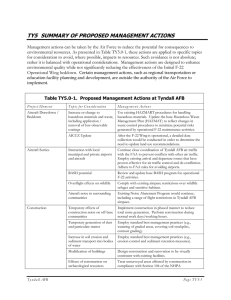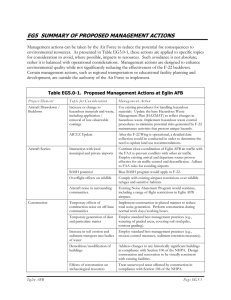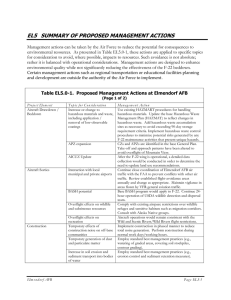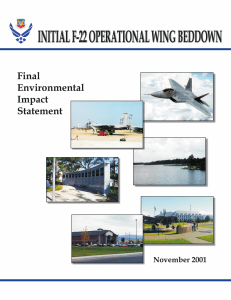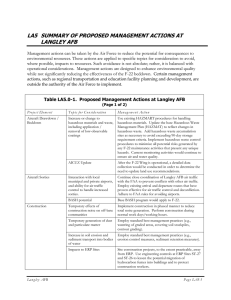SUMMARY .l.O
advertisement
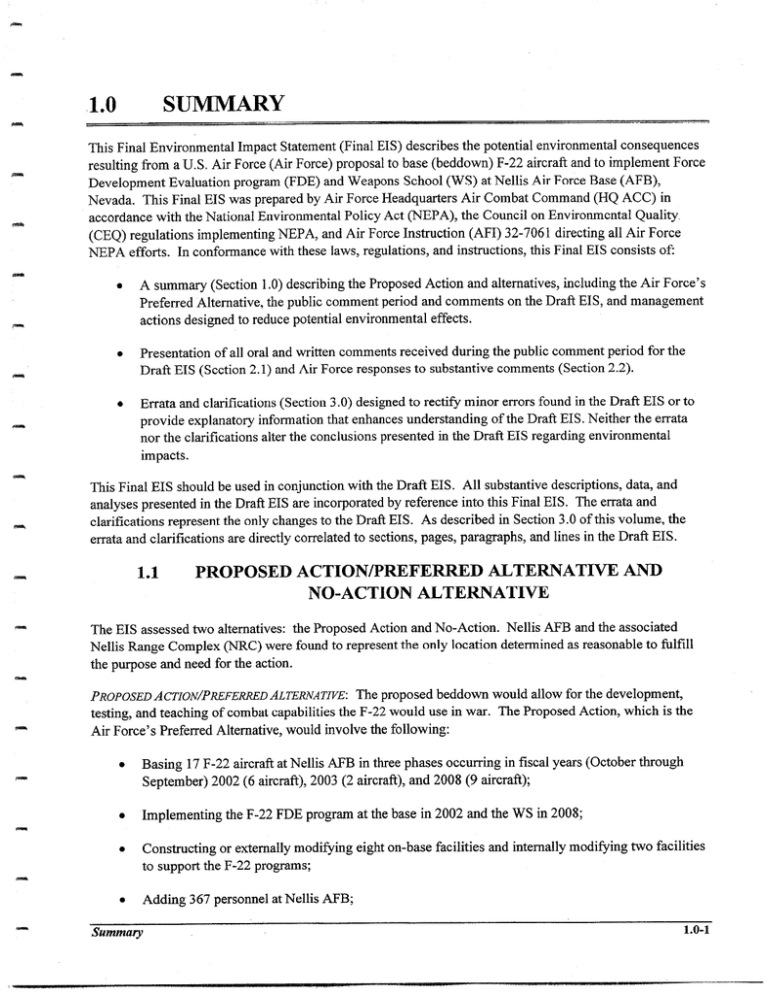
SUMMARY .l.O This Final Environmental Impact Statement (Final EIS) describes the potential environmental consequences resulting from a U.S. Air Force (Air Force) proposal to base (beddown) F-22 aircraft and to implement Force Development Evaluation program (FDE) and Weapons School (WS) at Nellis Air Force Base (AFB), Nevada. This Final EIS was prepared by Air Force Headquarters Air Combat Command (HQ ACC) in accordance with the National Environmental Policy Act (NEPA), the Council on Environmental Quality (CEQ) regulations implementing NEPA, and Air Force Instruction (AFI) 32-706 1 directing all Air Force NEPA efforts. In conformance with these laws, regulations, and instructions, this Final EIS consists of: A summary (Section 1.O) describing the Proposed Action and alternatives, including the Air Force’s Preferred Alternative, the public comment period and comments on the Draft EIS, and management actions designed to reduce potential environmental effects. l Presentation of all oral and written comments received during the public comment period for the Draft EIS (Section 2.1) and Air Force responses to substantive comments (Section 2.2). l o Errata and clarifications (Section 3 .O) designed to rectify minor errors found in the Draft EIS or to provide explanatory information that enhances understanding of the Draft EIS. Neither the errata nor the clarifications alter the conclusions presented in the Draft EIS regarding environmental impacts. This Final EIS should be used in conjunction with the Draft EIS. All substantive descriptions, data, and analyses presented in the Draft EIS are incorporated by reference into this Final EIS. The errata and clarifications represent the only changes to the Draft EIS. As described in Section 3.0 of this volume, the errata and clarifications are directly correlated to sections, pages, paragraphs, and lines in the Draft EIS. 1.1 PROPOSED ACTION/PREFERRED ALTERNATIVE NO-ACTION ALTERNATIVE The EIS assessed two alternatives: the Proposed Action and No-Action. Nellis Range Complex (NRC) were found to represent the only location the purpose and need for the action. AND Nellis AFB and the associated determined as reasonable to fulfill PROPOSED ACTION/PREFERRED ALTERNATIVE: The proposed beddown would allow for the development, testing, and teaching of combat capabilities the F-22 would use in war. The Proposed Action, which is the Air Force’s Preferred Alternative, would involve the following: l l l l Summary Basing 17 F-22 aircraft at Nellis AFB in three phases occurring in fiscal years (October through September) 2002 (6 aircraft), 2003 (2 aircraft), and 2008 (9 aircraft); Implementing the F-22 FDE program at the base in 2002 and the WS in 2008; Constructing or externally modifying to support the F-22 programs; Adding 367 personnel at Nellis eight on-base facilities and internally modifying two facilities AFB; 1.0-l F-22 Force Development Evaluation and Weapons ScJzooJBeddown, Neltis AFB l l Conducting an additional 4,472 annual sorties from Nellis AFB by 2008, of which 4,300 would use the NRC and 172 would occur at remote ranges; and Testing ordnance delivery on approved targets and releasing chaff and flares in approved airspace. In compliance with CEQ regulations for implementing NEPA, the Air Force has identified the Preferred Alternative in this Final EIS. For the reasons outlined below, the Proposed Action is the Preferred Alternative. The proposed beddown would fulfill the defined purpose and need for the action. The Proposed Action would comply with Federal law, as well as Department of Defense and Air Force policy, which require the Air Force to conduct FDE testing of the F-22 aircraft and provide WS training for F-22 pilots. Beddown of F-22 aircraft at Nellis AFB and use of the unique assets offered by the NRC for testing and training meet the operational requirements of both the FDE program and WS. Nellis AFB and the NRC provide the military airspace, secure training ranges, range instrumentation and simulated threats, professional expertise, and infrastructure needed to implement the FDE program and WS for the F-22: NO-ACTIONALTERNATIV~ENVIRONMENTALLYPREFERREDALTER~~ATIVE: UnderNEPA,‘No-Action”means that the Proposed Action would not take place, and the resulting environmental effects from taking no action would be compared to those resulting from the Proposed Action. For this EIS, the No-Action Alternative means that no F-22 beddown would occur at Nellis AFB, no on-base construction or personnel increases associated with the F-22 would be implemented, and the FDE program and WS for the F-22 would not use the NRC. The No-Action Alternative is the Air Force’s Environmentally Preferred Alternative because it would result in no environmental impacts beyond baseline conditions. In comparison to the Proposed Action, the potential environmental consequences of the NorAction Alternative would be less. 1.2 PUBLIC AND AGENCY INVOLVEMENT PUBLICINVOLVEMENT: AFI 32-7061 and CEQ regulations require an early and open process for identifying significant issues related to a proposed action and obtaining input from the public prior to making a decision that could significantly affect the environment. These regulations specify public involvement at various junctures in the development of an EIS, including public scoping prior to the preparation of a Draft EIS and public review of the Draft EIS prior to preparing and publishing the Final EIS. A decision is made only after completion of the Final EIS and following a 30-day waiting period. Prior to the publication of the Draft EIS, the public involvement process included publishing the Notice Of Intent in the FederaZ Register on August 11, 1997. After public notification in newspapers and through radio stations, three scoping meetings, averaging 3 hours in duration, were held August 26 through August 28 at the following southern Nevada locations: Tonopah, Las Vegas, and Caliente. A total of 22 people attended the meetings. Of these 22, seven people provided oral input. By the end of the scoping period, September 30, 1997, 13 written comments had been received. The Draft EIS summarizes the issues raised during scoping. Following these scoping meetings, the Air Force prepared the Draft EIS and made it available to the public and agencies for review and comment. Official public notification commenced with the publication of the Notice of Availability (NOA) on June 18, 1999 in the Federal Register and the Las Vegas Review-Journal. Over 340 copies of the Draft EIS were sent to federal, state, and local agencies, Native American organizations, special interest groups, and citizens. The document was sent to those in the public who requested a copy and was made available at selected public facilities such as libraries and local government LO-2 Summary F-22 Force Development Evaluation and Weapons Sclzool Beddown, Nellis AFB agencies within southern Nevada. The public review and comment period for the Draft EIS lasted 45 days. During this time, hearings were held to provide an opportunity for the public to evaluate the proposal and the analysis contained within the Draft EIS. Public hearings were held in three Nevada communities potentially affected by the proposed action: Las Vegas, Caliente, and Tonopah from July 13 to July 15, 1999. The public was notified of the hearings through newspaper advertisements placed in the following: Las Vegas Review-Journal; ToBopah Times-Bonanza and Goldfield News; The Lincoln County Record (Caliente area); and The St. George Spectrum (west/central Utah). Advertisements supplying the time, date, and location were placed at least one week prior to the hearing dates to ensure proper public notification. A court reporter officially recorded comments and transcribed all communication during the presentation and public testimony at the hearings. Twenty-nine people attended the three hearings with nine people providing oral testimony and three submitting comment sheets. The Air Force received ten written comments during the public comment process. The closing date of the comment period was August 2, 1999. Comments received at the public hearings and during the comment period are addressed in this Final EIS (Section 2.1) and provided to the decisionmaker for consideration. The Final EIS also includes responses to these comments (Section 2.2). After publication of the Final EIS and a minimum of 30 days of review, the Air Force may publish a Record of Decision. AGENCYCONSULTATION:Both NEPA and CEQ regulations require intergovernmental notifications prior to any detailed statement of environmental impacts. Through the process of Interagency and Intergovernmental Coordination for Environmental Planning, concerned federal, state, and local agencies (such as the U.S. Fish and Wildlife Service [USFWS], ,Bureau of Land Management [BLM], Nevada Division of Environmental Protection, and the Nevada State Historic Preservation Officer [SHPO]) must be notified and allowed sufficient time to evaluate potential environmental impacts of a proposed action. For the F-22 EIS, this was accomplished in four ways: (1) agencies were contacted early in the EIS process via letters to solicit their comments on the Proposed Action and No-Action Alternative, (2) the Air Force conducted scoping meetings, (3) the Air Force sent copies of the Draft EIS to federal, state, and local agencies, and (4) the Air Force held three public hearings as described above. Comments from agencies on the Draft EIS are summarized below and addressed in Section 2.2 of this Final EIS. GOVERNMENT-TO-GOVERNMENTCONSULTATION: Several laws and regulations address the requirement for federal agencies to notify or consult with American Indian groups or otherwise consider their interests when planning and implementing federal undertakings. On April 29, 1994, the President issued tile Memorandum on Government-to-Government Relations with Native American Tribal Governments, which specifies a commitment to developing more effective day-today working relationships with sovereign tribal governments. The intent of this memorandum has been incorporated in the Department of Defense (DOD) American Indian and Alaska Native Policy and Executive Order 13084, Consultation and Coordination with Indian Tribal Governments, which the Air Force is following. The DOD American Indian and Alaska Native Policy supports tribal self-government and government-to-government relations with the Federal government. It specifies that DOD will meet its trust responsibilities to tribes and will address tribal concerns related to protected tribal resources, tribal rights, and Indian lands. The policy also addressesprocedures for building stable and enduring relationships with tribes. As part of the NEPA process, 17 tribes and one organization with historical ties to the land in the NRC vicinity were notified at the initiation of the EIS effort, sent copies of newsletters, fact sheets,and the Draft Summary 1.03 * F-22 Force Development Evaluation and Weapons School Beddown, Nellis AFB EIS, and briefed at the Native American Interaction Program meeting in June 1999. Discussion of the F-22 is part of an ongoing government-to-government consultation between Nellis AFB and these tribes. This ongoing consultation is directed through the Nellis AFB Native American Interaction Program. SUM~WRYOFCOMMENTSRECEIVEDFROA~THEPUBLICONTHEDRAFT EIS: Atotalof18 oralorwritten comments were received from the public or organizations regarding the Draft EIS. Based on the review of these comments, noise received the most interest. In Las Vegas, cornmentors raised the concern that increased noise generated by the F-22 and established land use plans would be incompatible. One commentor also questioned the validity of the methods used for noise analysis and the treatment of environmental justice in the Draft EIS. Comments were also made regarding safety and land use zoning, and the possibility of further housing development within and near Nellis AFB. Other commentors simply stated their support for the Proposed Action. For the area under or near the NRC, cornmentors expressed concern about sonic booms and possible negative impacts on their quality of life, as well as impacts to recreational and tourism opportunities. A few other comments raised questions as to how the F-22 would operate and the way in which it would fly within current airspace. One comment concerned potential conflicts with commercial or private aviation activities and reconfiguration of airspace boundaries. A member of the Moapa Valley Paiutes and the Western Shoshone National Council expressed concern that F-22 flight operations would impact cultural resources and affect the quality of life for these groups of Native Americans. SUMMARY OF AGENCY COMMENTS ON THE DRAFT ED: Four federal, state, and local agencies commented on the Draft EIS. Region IX of the U.S. Environmental Protection Agency made comments on the adequacy of the Draft EIS with regard to the alternative identification process, noise analysis methodology, a single calculation for hazardous waste, treatment of environmental justice concerns, and the need to define measures to reduce environmental effects of the beddown around the base. The U.S. Fish and Wildlife Service briefly commented on where and how the F-22s would fly in relation to the Desert National Wildlife Refuge. The Draft EIS was circulated for review among the State of Nevada’s Departments of Wildlife, Transportation, Parks, Utilities, Environmental Protection, Minerals, and Historic Preservation (also the SHPO). The single comment from the State of Nevada consisted of a reminder to construct any public drinking water systems on base according to state standards and codes. Clark County’s Department of Comprehensive Planning merely requested data on projected noise contours to assist in planning around the base should a decision be made to implement the Proposed Action. 1.3 MANAGEMENT ACTIONS TO REDUCE THE POTENTIAL ENVIRONMENTAL IMPACTS FOR Reduction of the potential for environmental impacts represents an important part of NEPA. Nellis AFB conducts several ongoing efforts designed to achieve reductions in the effect the base has on the community and to work with groups or members of the community to address issues. All of these efforts, as highlighted below, would continue to apply should the F-22 beddown occur. Nellis AFB also proposes to expand existing efforts to inform and work with minority and low-income populations around the base. By continuing these efforts and potentially expanding current community interaction, Nellis AFB would reduce the potential impacts associated with the F-22 beddown. NOISE ABATEMENTPROGRAM residential areas surrounding 1.0-4 Nellis AFB’s noise abatement program focuses on reducing noise over the base. By employing this program, Nellis AFB reduces noise effects on the Summary F-22 Force Development Evaluation and Weapons School Be&own, Nellis AFB general population, as well as affected minority and low-income populations. Procedures used in the Noise Abatement Program include: l l l Routing takeoffs to avoid residential areas as much as possible; Controlling and scheduling missions to reduce noise levels, especially at night or early in the morning; Altering the speed, rate of climb, and turning radius of aircraft to reduce overall time over residential areas and reduce time at low altitudes; l Minimizing the use of afterburners for takeoff; l Avoiding practice approaches early in the morning on weekends and holidays; l l Conducting aircraft engine run-ups in a portion of the airfield designed to minimize the exposure of surrounding residential areas to noise; and Minimizing late-night engine run-ups. All of these management actions have served to reduce noise and its effects on the population near Nellis AFB. If the decision were made to beddown F-22s at Nellis AFB, the Air Force will continue to evaluate the noise generated by the aircraft. Should further feasible noise abatement procedures be identified at the time of the beddown, the Air Force would assessand potentially implement them. AIR~NSTALLATION~OMPATIBLEUSEZONEPROGRAMTheAirCompatibleUseZoneProgram(AICUZ)isan ongoing program for all Air Force airfields. It is designed to assist the adjacent community by recommending land use planning that ensures safe aircraft operations and minimizes noise impacts to the community. Elements of the AICUZ program include: l Maintaining a cooperative, open dialogue between the base and the community for land use planning; l Offering assistanceto the community in planning for changes in aircraft operations and noise; and l Developing noise contours around a base that can be used by the community for zoning ordinances. Nellis AFB has conducted the AICUZ program for almost two decades. The base continues to work with the Clark County Planning Commission to recommend concepts for land use plans and zoning ordinances. The county has adopted many of those recommendations to reduce the potential for conflicts between aircraft operations at Nellis AFB and development in the nearby community. PROPOS~MINORITYANDLOW-INCOMECOMMUNITYINTERACTION: Nellis AFB hasbeen apt-tofthe Las Vegas metropolitan area community for more than 50 years. Like any major institution in a community, being a good neighbor is a top priority. At Nellis AFB, this has resulted in a public outreach program through such events as air shows and restoration advisory board meetings. To augment specific outreach efforts, Nellis AFB proposes to expand its community interaction program to provide more emphasis on the minority and low-income populations around the base. This effort would aid these segments of the community in understanding the function and importance of Nellis AFB, as well as provide a focused Summary 1.04 F-22 Force Development Evaluation and Weapons School Beddown, Nellis AFB opportunity for minority and low-income Noise from aircraft operations, including populations to work with the base on issues concerning them. those by F-22s, would likely be a principal topic of the program. NATIVEAMERICANINTERACTIONPROGRAM Nellis AFB has a comprehensive Native American Interaction Program and conducts substantial government-to-government relations with Native Americans affected by activities at the base and in the NRC. This ongoing interaction program addressed the F-22 proposal and EIS through: l Direct notification of the initiation of the EIS process to 17 tribes and one organization historic or prehistoric ties to the land in the NRC vicinity; to ensure that the 17 tribes and one organization with 0 Communication meetings; were invited to scoping o Direct distribution of copies of the Draft EIS to the tribes to ensure their awareness of the proposal and its potential effects, and to receive comments from them; and o Meeting with the tribes after receipt of comments briefing of status and schedule of the F-22 NEPA on the Draft EIS and providing process and F-22 program. Nellis AFB’s Native American Interaction Program and associated government-to-government would continue should the F-22 beddown occur. Any future issues from the Native Americans F-22 would be addressed through this program. an Air Force relations regarding the CULTURALRESOURCES:As described in the Draft EIS, the proposed site for the Munitions Maintenance and Storage Facility has not been surveyed for cultural resources. To comply with regulatory requirements for the protection of cultural resources, Nellis AFB would undertake the following management actions to reduce potential effects: l Survey of the construction l Evaluate any cultural resources identified l Perform l area prior to ground disturbance Section 106 consultation (before January 2000); as a result of the survey; with the Nevada SHPO; and If cultural resources deemed eligible for the National Register of Historic Places are identified, either avoid them or mitigate the effects to insignificant levels through data recovery. 1.4 DECISIONS TO BE MADE After considering the environmental information presented in this EIS, as well as other factors relative to national defense, the Air Force will decide whether to implement the Proposed Action or to select the NoAction Alternative. A decision to proceed with the Proposed Action would result in basing the F-22 aircraft for FDE and WS at Nellis AFB and implementing associated supporting actions. If the No-Action Alternative were selected, the F-22 aircraft beddown for the purpose of FDE and WS training would not occur at Nellis AFB. Selection of the No-Action Alternative may affect the timing of F-22 integration into the Air Force. 1.0-6 Summav
